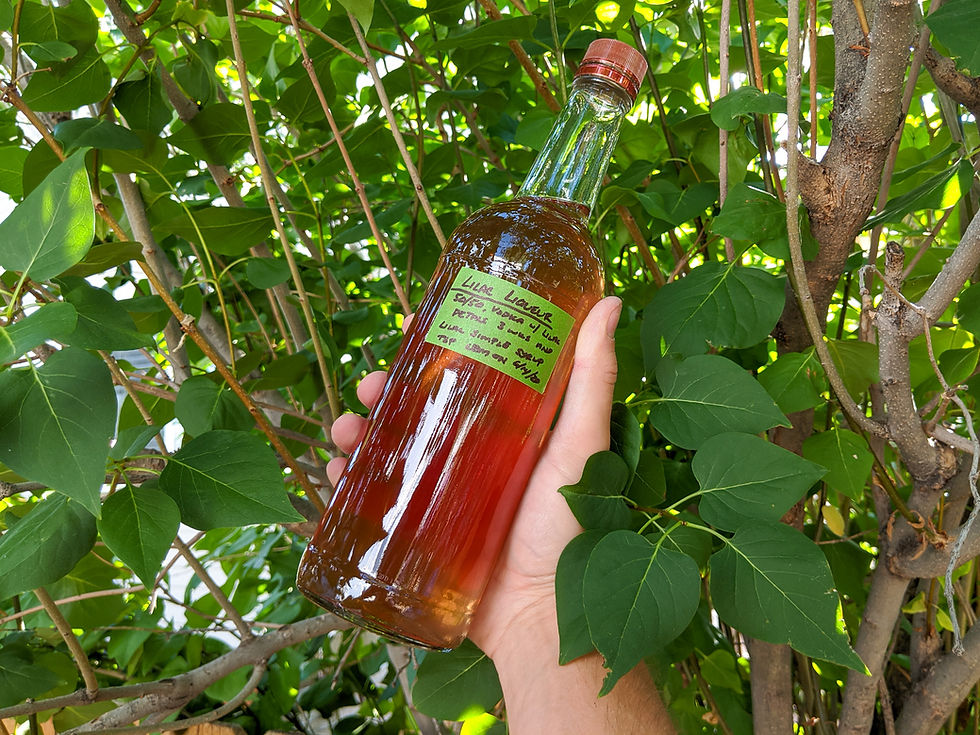How to Forage Lilac: Fragrant and Edible!
- Orion Aon

- Jul 30, 2024
- 3 min read
Lilacs are well known for their beautiful flowers and strong, perfumy smell. They're less known for their edibility and use as wild food! Let's learn how to identify lilac, where it can be found, some look-alikes, and how to eat it!

Description
Common lilac, Syringa vulgaris, is a medium to large, multi-stemmed shrub. It usually grows 8 to 12 feet tall but can occasionally reach heights of over 20 feet. It can also sometimes exhibit a tree-like shape, especially when pruned for those traits. Lilac leaves are oval to heart-shaped, simple, and opposite, with smooth margins.

The flowers bloom in dense clusters on the apex of the branches and are usually some shade of purple, though they can sometimes by white. The individual flowers are tube-shaped with four petals or lobes. They quickly become small green capsules that mature into brown seed pods containing winged seeds.

Range & Habitats
Common lilac is native to southeastern Europe, specifically the Balkan Peninsula. However, it can now be found throughout much of the Northern Hemisphere and parts of South America and Australia, where it is used as an ornamental plant because of its lovely flowers and scent. In its native range, it tends to grow along rocky hills. Throughout the world, it’s more commonly seen near humans. In some parts of Colorado, where I am located, it can be found naturalized in the rocky canyon walls along our low-elevation rivers.

Potential Look-alikes
The information in the description above should be enough to identify lilac properly. However, look-alike information is regularly requested, so here are some possible species that could be confused with lilac. This list is not comprehensive and may not be relevant to your region. Remember only to eat wild foods once you're 100% confident in your identification and comfortable with trying something new.
Crepe myrtle, Lagerstroemia indica, has clusters of purple flowers. They tend to bloom in the summer, and the petals are frilly and not defined. They are apparently also edible, though I have no personal experience eating them.
Hydrangea species can sometimes have spikes of purple flowers that resemble lilacs. Edibility requires some more research. Some sources claim yes, but others mention cyanogenic compounds.
Butterfly bush, Buddleja species, can have clusters of purple flowers that resemble lilacs. Some species are safe to consume, but not all.
Wisteria species could be confused with lilacs because they grow in clusters and are purple, but the resemblance stops there. These flowers are pea or bean-like because wisteria is a legume. Only the flowers are edible; all other parts of wisteria are toxic.
New Mexico locust and other smaller, pink flowering species of locust. These flowers are also edible and, like wisteria, are pea or bean-like.

Join The Forage Colorado Newsletter!
Sign up for our email newsletter to get seasonal foraging tips, wild food classes,
early access to foraging events, and more!
Edibility & Foraging Lilac
When foraging lilac, there's only one edible part to focus on: the flowers. They bloom for around a month before they turn brown and fall off the plant to become seed pods. If you live in a location with elevation, like I do, you can extend their season by going up in elevation! I know of some lilacs growing above 10,000ft in elevation that flower around late July. To harvest the flowers, choose clusters in peak bloom or just before it, with some unopened flower buds. Try to avoid clusters with lots of brown flowers. Using pruners or stout scissors, clip the cluster from the shrub and place it in a container for transport. I like using a small bucket with water to keep the cut stem hydrated.

Once home, carefully remove the flowers from the stems and branches. Avoid getting too many stems into the harvest flowers, as they will add bitterness to whatever you make. One of my favorite uses for the flowers is lilac liqueur. I have made it a few different ways, and they all need some aging before the flavor really develops, but it's worth the effort and wait! Try this recipe for Creme de Lilac from my friend Ellen Zachos of Backyard Forager. You could also try making lilac jelly using any flower jelly recipe.

Foraging Calendar
To learn more about the best seasons to harvest this species and many other wild foods, check out my Foraging Calendar & Wild Food Database! You can try the demo version to learn more, and join my Patreon to gain full access to the Foraging Calendar and other exclusive perks! Joining is the best way to support all the work I put into my content and website to help you learn about foraging! Thank you for checking it out!





Comments